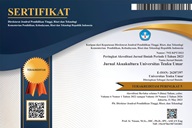OPTIMASI WAKTU PEMBELAHAN SEL DAN SUHU KEJUTAN TERHADAP TINGKAT KEBERHASILAN TRIPLOID IKAN SERUKAN (Osteochilus sp.)
Abstract
Full Text:
PDF (Bahasa Indonesia)References
Alawi, Nuraini, H., & Sapriana. (2009). Induksi Triploid Ikan Selais (Kryptopterus lympok) Mengunakan Kejutan Panas. Jurnal Perikanan dan Kelautan. 14(1): 37-47.
Beaumont, A.R., & Hoare, K. (2003). Biotechnology and Genetics in Fisheries and Aquaculture. Oxford [GB]: Blackwell Science. hlm 158-160.
Berrill, I.K., MacIntyre, C.M., Noble, C., Kankainen, M., & Turnbull, J.F. (2012). Bio-economic Costs and Benefits of Using Triploid Rainbow Trout in Aquaculture: Reduced Mortality. Aquacult Eco Mgmnt. 16(2):365-383.
Carman, O., Oshiro, T., & Takashima, F. (1991). Estimation of effective condition for induction of triploidy in goldfish Carassius auratus Linnaeus. J Tokyo Univ Fish. 78(2):127-135.
Carman, O. (1992). Cromosome Set Manipulation in Some Warm-Water Fish. Doctoral Thesis. Tokyo University of Fisheries. Tokyo. Hal 131.
Dunham, R.A. (2006). Aquaculture and Fisheries Biotechnology: Genetic Approaches. Cambridge [US]: CABI. hlm 372-376.
Effendi, M.I. (1997). Biologi Perikanan. Yayasan Pustaka Nusantara. Yogyakarta. Hal 134-187.
Hartono, D.P., & Witoko, P. (2012). Pengaruh Jarak Waktu Pemberian Kejutan Dingin pada Pembentukkan Individu Triploid Ikan Patin (Pangasius sp). Jurnal Penelitian Pertanian Terapan. Politeknik Negeri Lampung. 12(3): 156-162.
Gheyas, A.A., Mollah, M.F.A., & Hussain, M.G. (2001). Triploid Induction in Stinging Catfish Heteropneutes fossilis Uisng Cold Shock. Asian Fisheries Science. 14(3):323-332.
Gjedrem, T., & Baranski, M. (2009). Selective Breeding in Aquaculture: An Introduction. London [GB]: Springer. hlm 221.
Haloho, M.D.T. (2015). Efektivitas Triploidisasi dengan Penetasan dan Suhu Kejutan Yang Berbeda Pada Ikan Ingir-ingir (Mystus nigriceps). Skripsi. Fakultas Perikanan dan Ilmu Kelautan Universitas Riau. Pekanbaru. hlm 44-57.
Howell, W.M., & Black, D.A., (1980). Controlled Silver Staining of Nucleolus Organizer Regions with Protective Colloidal Developer: a1-step methods. Experientia. 36(2):1014-1015.
Ibrahim, Y., Soelistyowati, D.T., & Carman, O. (2017). Triploid Striped Catfish Pangasianodon hypophrhalmus: Growth Performance and Gonadal Development. Jurnal Akua Indonesia. 16(1):76-82.
Kligerman, A.D., & Bloom, S.E. (1977). Rapid Chromosome Preparations from Solid Tissues of Fishes. J Fish Res Board Can. 34(3):266-269.
Lagler, K.F. (1970). Freshwater Fishery Biology. WM. C. Brown Comp. Publishers. Dubuque. Lowa. Hal 371-191.
Liu, S.J., Qin, Q.B., Xioa, J., Lu, W.T., Shen, J.M., Li, W., Liu, J.F., Duan, W., Zhang, C., Tao, M., Zhao, R.R., Yan, J.P., & Liu, Y. (2007). The formation of the polyploid hybrids from different subfamily fish crossings and its evulotionary significance. Genetics. 176(2):1023-1034.
Muchlisin, Z.A., Arfandi, G., Adlim, M., Fadli, N., & Sugianto. (2014). Induced Spawning of Seurukan Fish Osteochilus vittatus (Pisces: Cyprinidae) Using Ovaprim, Oxytocin and Chicken Pituitary Gland Extracts. AACL Bioflux. 7(5):412-418.
Mulyasari, D.T., Soelistyowati, A.H., Kristanto, & Kusmini, I.I. (2010). Karakteristik Genetik Enam Populasi Ikan Nilem (Osteochilus hasselti) di Jawa Barat. Jurnal Riset Akuakultur. 5 (2):175-182.
Mukti, A.T., Rustidja, Sumitro, S.B, & Djati, M.S. (2001). Poliploidisasi Ikan Mas (Cyprinus carpio L). Jurnal Biosin. 1(1): 17-25
Myers, P.R., Espinosa, C.S.P., Jones, G.S., Hammond, & Dewey, T.A. (2014). The Animal Diversity Web (online). Accessed at http://animaldiversity.org.
Nam, Y.K., Park, I.S., & Kim, D.S. (2004). Triploid hybridization of fast-growing transgenic mud loach Misgurnus mizolepis male to cyprinid loach Misgurnus anguillicaudatus female: the first performance study on growth and reproduction of transgenic polyploid hybrid fish. Aquaculture. 231:559-572.
Nurasni, A. (2012). Pengaruh Suhu dan Lama Kejutan Panas Terhadap Triploidisasi Ikan Lele Sangkurian (Clarias gariepinus). Tesis Universitas Padjadjaran. Sumedang. Tidak Dipublikasikan. Hlm 34-41.
Park, I., Nam, Y.K., & Kim, D.S. (2006). Growth performance, morphometric traits and gonad development of induced reciprocal diploid and triploid hybrids between the mud loach (Misgurnus mizolepis Günther) and cyprinid loach (Misgurnus anguillicaudatus Cantor). Aquacult Res. 37(5):1246-1253.
Piferrer, F., Beaumont, A., Falguière, J.C., Flajšhans, M., Haffray, P., & Colombo, L. (2009). Polyploid fish and shellfish: production, biology and applications to aquaculture for performance improvement and genetic containment. Aquaculture. 293(7):125-156.
Sastrawibawa, S. (2003). Jumlah Kromosom dan Anak Inti Ikan Tawes Diploid (Puntius gonionotus Blkr). Jurnal Bionatura. 5(1):21-28.
Subagia, J., Gustiano, L., & Winarlin. (2006). Pelestarian Ikan Nilem (Osteochilus sp.) Melalui Teknologi Pembenihan. Lokakarya Nasional Pengelolaan dan Pelindungan Sumber Daya Genetikdi Indonesia. Hal:279-286.
Sukarti, K., Djawat, I., & Fujaya, Y. (2006). Pengaruh Lama Kejutan Panas Terhadap Keberhasilan Triploidisasi Ikan Lele (Clarias batrachus). Jurnal Sains dan Teknologi. 6 (3):135-142.
Susilo, R.H., Farikhah, F., & Rahim, R.A. (2018). Analisis Jumlah Kromosom Pada Triploidisasi Ikan Mas (Cyprinus carpio linn) Ras Punten Dengan Lama perendaman Kejut Suhu Panas Yang Berbeda. Jurnal Perikanan Pantura. Universitas Muhammadiyah Gresik. 1(1).76-88
Syandri, H. (2004). The Use of Osteochilus vittatus and Puntius javanicus Asa an Agen of Biological in Maninjau Lake. Journal of Natur Indonesia. 6(2):87-91.
Thorgaard, G.H., & S.K. Allen Jr. (1987). Chromosome manipulation and markers in fisheries management. In. Ryman, N., Utter, F. (Eds.), Population Genetics and Fishery Management. University of Washington. Washington. US.
DOI: https://doi.org/10.35308/ja.v5i1.4515
Refbacks
- There are currently no refbacks.



